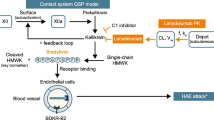Abstract
Anti-platelet drugs are generally screened by evaluating their ability to influence initiation and development of irreversible aggregation of platelets. However, to fully characterize the inhibitory effects of an agent, it is essential to determine if it can also disperse irreversibly aggregated cells, whether drug-treated, dispersed platelets are refractory, sensitive to some but not all aggregating agents, as sensitive to all agents as before initial exposure, hypersensitive or whether they can be restored to a sensitive state by modulation of the platelet membrane. We have developed anvitro system for evaluating the influence of a variety of agents on disaggregation and reaggregation of aggregated blood platelets. Results demonstrate that some agents which inhibit aggregation can also cause disaggregation, while others cannot. The ability to disaggregate is often selective, revealing a dependence on the nature of the agent causing aggregation, and the time after irreversible aggregation that the inhibitor is added. Agents that elevate intracellular cyclic adenosine monophosphate levels were potent inducers of platelet dissociation in aggregates caused by adenosine diphosphate. On the other hand, antimalarials, calmodulin complexing agents and phospholipase inhibitors caused dissociation of platelet aggregates, irrespective of the agonist used. By and large, the dissociated cells were refractory to the action of agonists. Restoration of the sensitivity of disaggregated platelets by treatment with epinephrine demonstrate an ability of inhibitor treated, refractory platelets to recover full functional capacity almost immediately. Thus, careful study of the effects of inhibitors on disaggregation, recovery and reaggregation may reveal features critical to the selection of anti-platelet drugs for clinical utilization.
Similar content being viewed by others
References
J. Hirsh, Role of platelets in thrombosis: rationale for use of anti-platelet drugs. InMechanisms of Hemostasis and Thrombosis (EdsC.H. Mielke andR. Rodvien). Symposia Specialists, Miami 1978.
L.A. Harker, R. Ross andJ. Glomset,Role of platelet in atherogenesis, Ann. N.Y. Acad. Sci.275, 321–329 (1976).
L.A. Harker andJ.L. Richie,The role of platelets in acute vascular events, Circulation62 (Suppl. V), V13-V18 (1980).
M.A. Packham andJ.F. Mustard,Clinical pharmacology of platelets, Blood50, 555–573 (1977).
J. Hirsh,Platelet inhibitors in the treatment of thrombosis, Clin. Invest. Med.1, 191–206 (1979).
A.S. Gallus andJ. Hirsh,Anti-thrombotic drugs, Part II, Drugs12, 132–146 (1976).
H.J. Weiss,Platelet-active drugs in the secondary prevention of cardiovascular events: an overview, Circulation62 (Suppl. V), V41-V43 (1980).
E. Genton,A perspective on platelet-suppressant drug treatment in coronary artery and cerebrovascular disease, Circulation62 (Suppl. V), V111-V121 (1980).
E. Braunwald,Treatment of the patient after myocardial infarction: the past decade and the next, New Engl. J. Med.302, 290–293 (1980).
G.V.R. Born,Quantitative investigations into the aggregation of blood platelets, J. Physiol., Lond.162, 67P-68P (1962).
R.D. Feinman, J. Lubowsky, I.F. Charo andM.P. Zabinski,The lumiaggregometer: a new instrument for simultaneous measurements of secretion and aggregation, J. Lab. clin. Med.90, 125–129 (1977).
G.H.R. Rao, K.R. Reddy andJ.G. White,The influence of epinephrine on prostacyclin (PGI 2)induced dissociation of ADP aggregated platelets, Prost. and Med.4, 385–397 (1980).
G.H.R. Rao, K.R. Reddy andJ.G. White,Influence of trifluoperazine on platelet aggregation and disaggregation, Prost. and Med.5, 221–234 (1980).
G.H.R. Rao andJ.G. White,Disaggregation and reaggregation of irreversibly aggregated platelets, Circulation62, 1053A (1980).
G.H.R. Rao andJ.G. White,Arachidonate metabolism and platelet disaggregation-reaggregation, Thromb. Haemostas.46, 856A (1981).
G.H.R. Rao, G.J. Johnson, K.R. Reddy andJ.G. White,Rapid return of cyclooxygenase active platelets in dogs after a single oral dose of aspirin, Prostaglandins22, 761–772 (1981).
J.G. White,The sub-membrane filaments of blood platelets, Amer. J. Path.56, 267–271 (1969).
G.H.R. Rao, A.C. Cox, J.M. Gerrard andJ.G. White,Effects of 2,2′-dipyrydil and related compounds on platelet prostaglandin synthesis and platelet function, Biochim. biophys. Acta628, 468–479 (1980).
M. Cattaneo, R.L. Kinlough-Rathbone, D.W. Perry, A. Chahil, J.D. Vickers, S.C.T. Lam, M.A. Packham andJ.F. Mustard,The inhibitory effects of exogenous arachidonic acid on rabbit platelet aggregation and the release reaction, Blood60, 1179–1187 (1984).
G.C. LeBreton andD.L. Venton,Thromboxane A 2 receptor antagonist selectively reverses platelet aggregation, Adv. Prost. and Thrombox. Res.6, 497–503 (1980).
E.J. Harfenist, M.A. Packham andJ.F. Mustard,Reversibility of the association of fibrinogen with rabbit platelets exposed to ADP, Blood56, 189–198 (1980).
A. Morita, M. Mori, K. Hasegawa, K. Kojima andS. Koyabashi,Anti-platelet aggregating and disaggregating activities of 6,9-methano-PGI 2, Life Sci.27, 695–701 (1980).
J.F. Martin, A.J. Suggett, E. Leach andS. Moncada,The effect of prostacyclin on platelet aggregation and disaggregation in vivo, Thromb. Res.18, 749–751 (1980).
M. Rodomski, J. Swies andR.J. Gryglewski,Disaggregatory action of phosphodiesterase inhibitors, Pharmacol. Res. Comm.13, 41–47 (1981).
I. Aursnes,Preactivation and deactivation of blood platelets, Thromb. Haemostas.47, 3–4 (1982).
R.L. Kinlough-Rathbone, J.F. Mustard, D.W. Perry, E. Dejana, J.P. Cazenave, M.A. Packham andE.J. Harfenist,Factors influencing the deaggregation of human and rabbit platelets, Thromb. Haemostas.49, 162–167 (1983).
J.B. Smith,The prostanoids in hemostasis and thrombosis: a review, Am. J. Path.99, 743–766 (1980).
Coronary Drug Project Research Group,Aspirin in coronary heart disease, J. Chron. Dis.29, 625–642 (1976).
Aspirin Myocardial Infarction Study Research Group,A randomized controlled trial of aspirin in persons recovered from myocardial infarction, J. Am. med. Ass.243, 661–669 (1980).
J. Hirsh,Platelet inhibitors in the treatment of thrombosis, Clin. Invest. Med.1, 191–206 (1979).
G.H.R. Rao, G.J. Johnson andJ.G. White,Influence of epinphrine on the aggregation response of aspirintreated platelets, Prost. and Med.5, 45–58 (1980).
G.H.R. Rao, J.M. Gerrard, C.J. Witkop andJ.G. White,Platelet aggregation independent of ADP release or prostaglandin synthesis in patients with the Hermansky-Pudlak syndrome, Prost. and Med.6, 459–472 (1981).
B.B. Vargaftig, F. Fouque, J. Benveniste andJ. Odiot,Adrenaline and PAF-acether synergize to trigger cyclooxygenase independent activation of plasma-free human platelets, Thromb. Res.28, 557–573 (1982).
A.C. Cox, R.C. Carroll, J.G. White andG.H.R. Rao,Recycling of platelet phosphorylation and cytoskeletal assembly, J. Cell Biol.98, 8–15 (1984).
Author information
Authors and Affiliations
Rights and permissions
About this article
Cite this article
Rao, G.H.R., White, J.G. Disaggregation and reaggregation of ‘irreversibly’ aggregated platelets: A method for more complete evaluation of anti-platelet drugs. Agents and Actions 16, 425–434 (1985). https://doi.org/10.1007/BF01982884
Received:
Accepted:
Issue Date:
DOI: https://doi.org/10.1007/BF01982884




